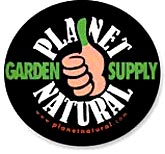Soil blocks, compressed soil for seedlings, come recommended by almost everyone who tries them, as long as they can get the things to hang together. The web is full of grumbling from people whose blocks disintegrated when moved, planted, or breathed on, and accolades from those who changed their soil mix and found success. The word is out: don't skimp here, and for once I decided to take that advice. Sort of.
So a couple of Fridays back I headed for Planet Natural* for my soil block ingredients: coconut coir, perlite, and greensand. We had barely time to unload the car and wash up before joining husband Steve for a soup dinner benefiting a local artist's studio group and then a local production of the Rocky Horror Picture Show. Abdoulaye came along for all of it, so he got to meet Eric at PN, have a tomato soup that couldn't be beat, and then see a show that really has no equivalent in Mali.**
Over the weekend a friend and I hauled everything outside and prepared the mix. Here's the recipe I got on-line at Jason Beam's site, where I ordered my molds:
Recipes for Blocking Mix:
http://www.pottingblocks.com/recipes.html
Step 1–Base Fertilizer
-
1 cup blood meal or feather meal or cotton seed meal or shrimp or crab meal or alfalfa meal, or soy bean meal, (or 1/2 cup kelp meal to 1/2 cup other meals.)
- 1 cup colloidal phosphate (soft
rock phosphate) - 1 cup greensand
-
1 cup glacial rock dust or mined
rock dust
Mix together thoroughly.
Step 2–Blocking Soil
-
3 buckets brown peat or half peat moss and half coco peat or coco pith/fiber
- 1/2 cup lime. MIX
- 2 buckets coarse perlite, pumice
stones, or diatomite rock (all screened to <1/4") - 4 cups base fertilizer. MIX
- 1 bucket good garden soil.
-
2 buckets compost, thoroughly
decomposed.
Note: There's much more information on the recipe page than I've reproduced here!
Substitutions:
I'm using coir instead of peat moss, since it functions in much the same way but is a renewable resource, being derived from coconut husks rather than thousand-year-old bogs. There's a discrepancy between the information on Jason Beam's website and the recipe above, also from the website: while the recipe treats coco peat and coco pith/fiber/coir as identical, the FAQ page on Beam's site draws a sharp distinction between them: “The pith is from the stringy coconut waste, the peat is ground up shell, pulverized and gritty, not suitable for blocks without adding peat moss. Know the difference." . While the recipe I've reprinted above says to mix either coir or coco peat with an equal quantity of peat moss, the FAQ page says that coir can be used on its own in soil blocks.
In his e-book Transplants in Soil Blocks (free on the Beam website), David Tressemer recommends starting with a screened peat which he then re-screens to eliminate all large particles. Coir, so far as I know, doesn't come in different grades, and I, er, left out the screening, so there are long threads protruding from some of my blocks. And yes, if I pull on one, sometimes the block simply disintegrates. That should teach me to leave well enough alone.
ON THE OTHER HAND, coir comes highly recommended by the Ladbrooke folks. Way down on their info page, which is where you end up if you click on "What kind of soil do I use?" on the home page, there's a heading "What kind of peat do I use?" which touts the wonders of coconut coir.
The lime in the recipe is needed to counterbalance the acidic peat, so I left it out, as coir's pH is higher than peat's. Besides, it's a reasonable guess that the “good garden soil” I used has higher than optimal pH, since this is, after all, a Montana valley. (The mountains, for reasons that I don't yet understand, are quite acidic; hence all the blueberries and huckleberries, which generally don't grow in the valleys.)
As for the perlite, I ended up with fine rather than coarse, so I crossed my fingers and went with that. Since my own compost isn't ready yet, I fell back on a commercial mix of vermicompost, humus, and compost, which also contains both endo and ecto mycorrhizae.
I didn't have exactly the fertilizer ingredients called for (okay, when you get right down to it I didn't have exactly anything!), but If you look at the list, it's clearly designed to provide equal quantities of nitrogen in the form of the blood, feather, shrimp, or alfalfa meals; phosphate (the colloidal phosphate); potassium (the greensand) and trace minerals (rock dust and greensand). The blood meal I have, the greensand I bought. The others? Not so much.
Instead of colloidal phosphate and rock dust, I re-crossed my fingers and used what's in the garage already: for phosphate, steamed bone meal, and for potassium, Kmag Natural Granular Potassium Magnesium Sulfate. Both are slow release nutrients, so I'm hoping they'll stand in for the recommended items. (The only fertilizer used by Tressemer is basalt rock powder.) Since I used four other sources, all of which do provide trace minerals (one of the major advantages of organics over pure, commercial fertilizers), I think the bases should be covered. My mix might be (gulp) just a tad heavy on potassium, what with the greensand and the Kmag. Not to mention the bit of wood ashes I tossed in. If anyone knows right off that I've poisoned my plants, please break it to me gently.
Here's my final mix:
Fertizer:
-
1 c. blood meal
- 1 c. steamed bone meal
- 2/3 c. Kmag PMS (Hmm.)
- 2/3 c. wood ash
- 1 c. greensand
Soil Mix:
-
3 buckets coconut coir
- 2 buckets fine perlite
- 4 cups base fertilizer.
- 1 bucket good (!) garden soil.
- 2 buckets commerical compost
Mixing
I and my friend stirred up a full batch of this stuff, which means that it's a good thing I bought a new, large wheelbarrow last year, because it was almost full. Instead of wetting the whole mess, however, I dumped most of it into a trash can and stashed it in the garage for use later.
Most sources say to stir up the mix, wet it down, and then leave it for at least several hours before using it. This allows the peat or coir, in particular, to absorb moisture and expand to its full size. My coir was already wet, having stood outdoors all winter (my bad), so I didn't bother with the wait. Since the blocks held together well, this method seems to work.
So, we put some of this golden mixture into a large rectangular plastic container, added enough water to make a sticky, soupy mess, and grabbed the molds. But there I must leave us, molds at the ready, until next post, and here, dear reader, I must leave you for now.
____________________________________
* My local source for organic gardening tools, ingredients, fertilizers, amendments, compost, etc. etc. etc., and home (well, workplace) of Eric Vinge, who commissions my gardening articles but who does not (repeat, NOT) pay me for this blog.
** Before reserving tickets, I'd tried to describe the show, so he wouldn't be taken completely off guard. (You try describing Rocky Horror Picture Show to someone from a different culture. I dare you.) Once there, though, I realized I'd forgotten quite how much of the show consists of scantily clad people prancing about, seducing each other, trying to seduce each other, stroking each other, and so on. There's also a difference between seeing this on a TV screen or even live in a large theater, and watching it in a tiny venue, where all that flesh (and sex) is only fifteen feet away. I really wondered if we'd overdone it this time, but Abdoulaye, ever game, dubbed it a “great experience.”
We have a curious history with this cult classic. We were living in Berkeley in the '80s, when the movie was shown every Saturday at midnight at a local cinema—and we never went! That would have been too easy. Instead, we first saw it in Japan, where we rented it after a Japanese friend invited us to join her at a live production. “Frank 'n' Furter is played by one of the most famous transvestites in Tokyo!” she told us, her eyes wide. How could we say no to that? We didn't. And it was a tremendous show, much better than the movie.

 Subscribe to RSS feed
Subscribe to RSS feed



We work with small and large companies like yours, providing custom software development, software testing, data base development, maintenance and other services related to software development. We are also happy to provide an analysis of the current status of your project, along with a proposal. Please contact me at your convenience.
Fertilizers must be applied to plants so that they will grow healthy. If they are healthy they will be bearing more fruits or whatever they produce. There are many suppliers of fertilizers nowadays. It just depends on who you will choose. But I have my own suppliers this time. They are reliable so no need to worry. Hope you have your own too.
http://www.wolfmountainproducts.com/